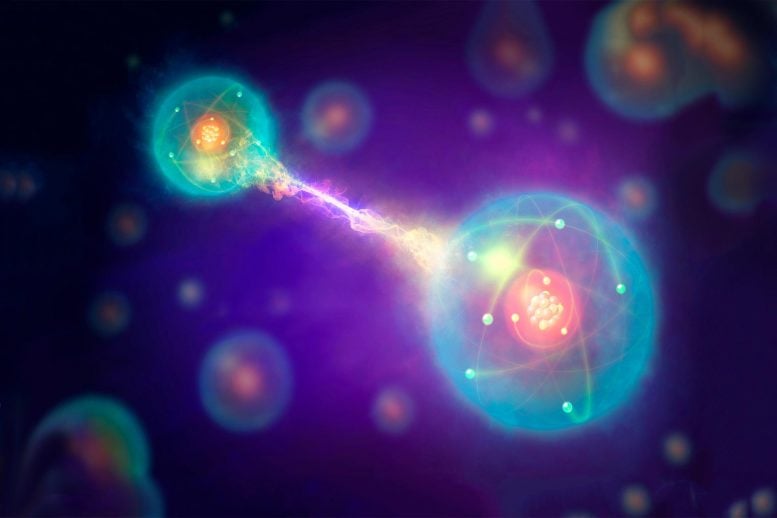
Researchers at Caltech have utilized quantum entanglement to double the resolution of light microscopes. The new technique, called quantum microscopy by coincidence, involves the entanglement of photons, which act as biphotons with double the momentum of a single photon. This results in a shorter wavelength, allowing the microscope to achieve greater resolution without damaging the specimens being observed, such as living cells. The team built an optical apparatus that used a special crystal to convert photons into biphotons and demonstrated microscopic resolution and cell imaging with their innovative system.
Caltech researchers have doubled the resolution of light microscopes using quantum entanglement, enabling higher-resolution imaging without damaging specimens like living cells.
Using a “spooky” phenomenon of quantum physics, Caltech researchers have discovered a way to double the resolution of light microscopes.
In a paper published on April 28 in the journal Nature Communications, a team led by Lihong Wang, Bren Professor of Medical Engineering and Electrical Engineering, shows the achievement of a leap forward in microscopy through what is known as quantum entanglement. Quantum entanglement is a phenomenon in which two particles are linked such that the state of one particle is tied to the state of the other particle regardless of whether the particles are anywhere near each other. Albert Einstein famously referred to quantum entanglement as “spooky action at a distance” because it could not be explained by his relativity theory.
According to quantum theory, any type of particle can be entangled. In the case of Wang’s new microscopy technique, dubbed quantum microscopy by coincidence (QMC), the entangled particles are photons. Collectively, two entangled photons are known as a biphoton, and, importantly for Wang’s microscopy, they behave in some ways as a single particle that has double the momentum of a single photon.
Since quantum mechanics says that all particles are also waves, and that the wavelength of a wave is inversely related to the momentum of the particle, particles with larger momenta have smaller wavelengths. So, because a biphoton has double the momentum of a photon, its wavelength is half that of the individual photons.
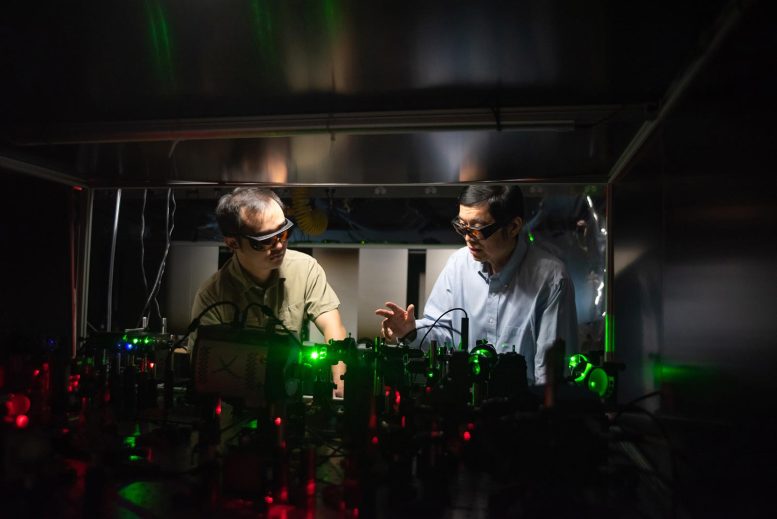
Zhe He (Postdoctoral Scholar Research Associate in Medical Engineering Andrew and Peggy Cherng Dept of Medical Engineering) and Lihong Wang (Bren Professor of Medical Engineering and Electrical Engineering; Andrew and Peggy Cherng Medical Engineering Leadership Chair; Executive Officer for Medical Engineering). Credit: Caltech
This is key to how QMC works. A microscope can only image the features of an object whose minimum size is half the wavelength of light used by the microscope. Reducing the wavelength of that light means the microscope can see even smaller things, which results in increased resolution.
Quantum entanglement is not the only way to reduce the wavelength of light being used in a microscope. Green light has a shorter wavelength than red light, for example, and purple light has a shorter wavelength than green light. But due to another quirk of quantum physics, light with shorter wavelengths carries more energy. So, once you get down to light with a wavelength small enough to image tiny things, the light carries so much energy that it will damage the items being imaged, especially living things such as cells. This is why ultraviolet (UV) light, which has a very short wavelength, gives you a sunburn.
QMC gets around this limit by using biphotons that carry the lower energy of longer-wavelength photons while having the shorter wavelength of higher-energy photons.
“Cells don’t like UV light,” Wang says. “But if we can use 400-nanometer light to image the cell and achieve the effect of 200-nm light, which is UV, the cells will be happy, and we’re getting the resolution of UV.”
To achieve that, Wang’s team built an optical apparatus that shines laser light into a special kind of crystal that converts some of the photons passing through it into biphotons. Even using this special crystal, the conversion is very rare and occurs in about one in a million photons. Using a series of mirrors, lenses, and prisms, each biphoton—which actually consists of two discrete photons—is split up and shuttled along two paths, so that one of the paired photons passes through the object being imaged and the other does not. The photon passing through the object is called the signal photon, and the one that does not is called the idler photon. These photons then continue along through more optics until they reach a detector connected to a computer that builds an image of the cell based on the information carried by the signal photon. Amazingly, the paired photons remain entangled as a biphoton behaving at half the wavelength despite the presence of the object and their separate pathways.
Wang’s lab was not the first to work on this kind of biphoton imaging, but it was the first to create a viable system using the concept. “We developed what we believe a rigorous theory as well as a faster and more accurate entanglement-measurement method. We reached microscopic resolution and imaged cells.”
While there is no theoretical limit to the number of photons that can be entangled with each other, each additional photon would further increase the momentum of the resulting multiphoton while further decreasing its wavelength.
Wang says future research could enable the entanglement of even more photons, although he notes that each extra photon further reduces the probability of a successful entanglement, which, as mentioned above, is already as low as a one-in-a-million chance.
Reference: “Quantum microscopy of cells at the Heisenberg limit” by Zhe He, Yide Zhang, Xin Tong, Lei Li and Lihong V. Wang, 28 April 2023, Nature Communications.
DOI: 10.1038/s41467-023-38191-4
The paper describing the work, “Quantum Microscopy of Cells at the Heisenberg Limit,” appears in the April 28 issue of Nature Communications. Co-authors are Zhe He and Yide Zhang, both postdoctoral scholar research associates in medical engineering; medical engineering graduate student Xin Tong (MS ’21); and Lei Li (PhD ’19), formerly a medical engineering postdoctoral scholar and now an assistant professor of electrical and computer engineering at Rice University.
Funding for the research was provided by the Chan Zuckerberg Initiative and the National Institutes of Health.

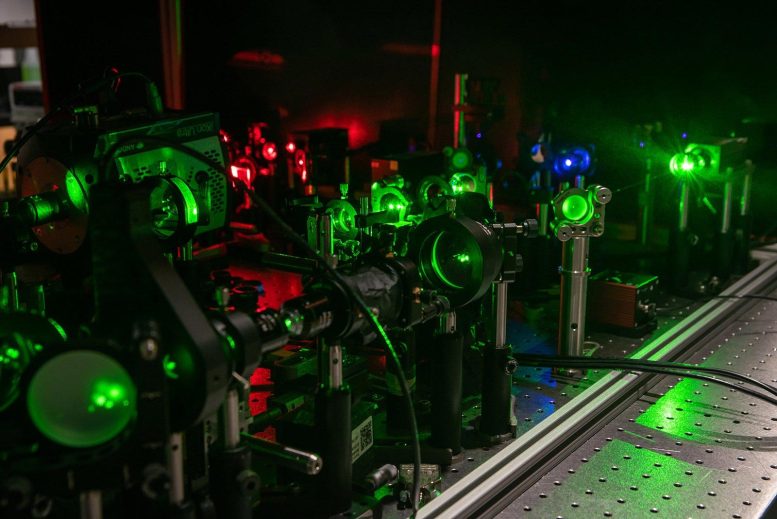
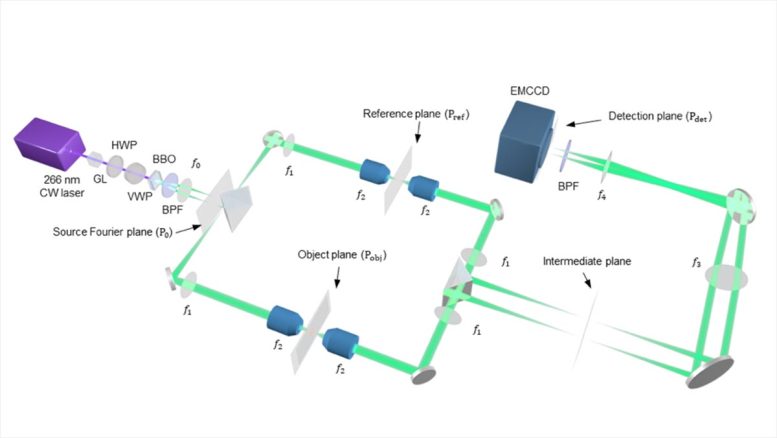
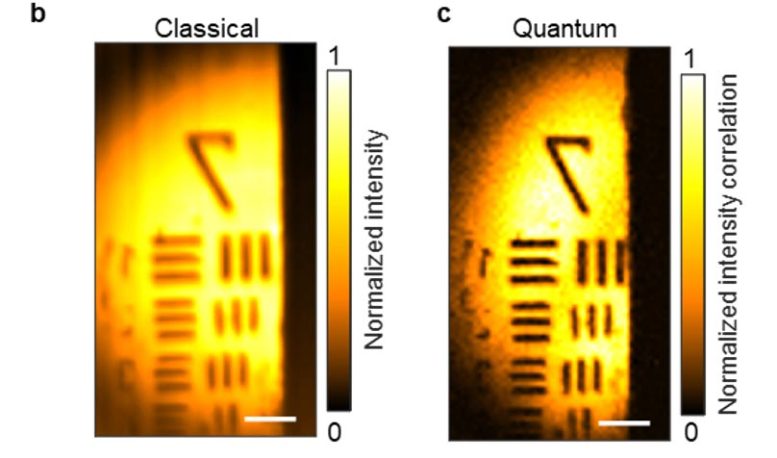
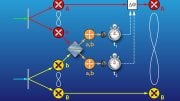
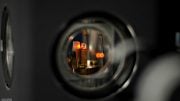
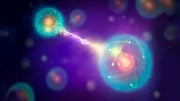
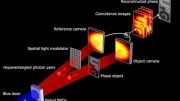
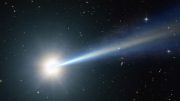
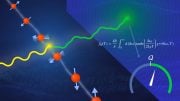

“Albert Einstein famously referred to quantum entanglement as ‘spooky action at a distance’”
Apparently he felt left out.
“each biphoton—which actually consists of two discrete photons—is split up and shuttled along two paths, so that one of the paired photons passes through the object being imaged and the other does not. The photon passing through the object is called the signal photon, and the one that does not is called the idler photon. These photons then continue along through more optics until they reach a detector connected to a computer that builds an image of the cell based on the information carried by the signal photon”
Not spooked yet…
“Amazingly, the paired photons remain entangled”
This is supposed to be the spooky part, I guess. All I get is the impression one photon is messed with by a sample being examined and the other photon is practically a twin but it is not messed with but serves as an “idler” reference photon for comparison. What the heck is spooky about it? No noise?
“the state of one particle is tied to the state of the other particle regardless of whether the particles are anywhere near each other”
This remains controversial with some physicists, but in any case it seems the useful property of entanglement here is as different from that as different can be, unsurprisingly, in that one of the pair is ideally completely unaffected by the other. The BS level is typical with this article, in other words.
More specifically, one of the entangled pair is ideally completely unaffected by the other up to, and not before, the two are combined in an interferometer. Thus, the snippet stating “the state of one particle is tied to the state of the other particle regardless of whether the particles are anywhere near each other” actually introduces maximal conceptual noise, which is unfortunately kind of typical for these sorts of releases.
Testing if posting works
And nos I get duplicated comment warning about a comment that the posting filter mysteriously disappeared. Probably due to double quote marks.
A quote: Albert Einstein famously referred to quantum entanglement as “spooky action at a distance” because it could not be explained by his relativity theory.
It turned out it can, by the discovery of modern quantum physics – the physics of effective quantum field theory – where the field and any particle trajectories (as in Feynman path integrals) and some of its effects such as entanglement correlation or quantum phases are mostly nonlocal.